
Rubiaceae is a family of flowering plants, commonly known as the coffee, madder, or bedstraw family. It consists of terrestrial trees, shrubs, lianas, or herbs that are recognizable by simple, opposite leaves with interpetiolar stipules and sympetalous actinomorphic flowers. The family contains about 14,100 species in about 580 genera, which makes it the fourth-largest angiosperm family. Rubiaceae has a cosmopolitan distribution; however, the largest species diversity is concentrated in the tropics and subtropics. Economically important genera include Coffea, the source of coffee; Cinchona, the source of the antimalarial alkaloid quinine; ornamental cultivars ; and historically some dye plants.
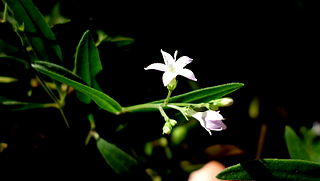
Pentodon is a genus of plants belonging to the family Rubiaceae. There appear to be only two species in the genus. They are found in Central America, Central and Southern Africa and the Seychelles.

Oldenlandia is a genus of flowering plants in the family Rubiaceae. It is pantropical in distribution and has about 240 species. The type species for the genus is Oldenlandia corymbosa.
Mitriostigma barteri is a species of plant in the family Rubiaceae. It is found in Cameroon and Equatorial Guinea. Its natural habitat is subtropical or tropical moist lowland forests. It is threatened by habitat loss.
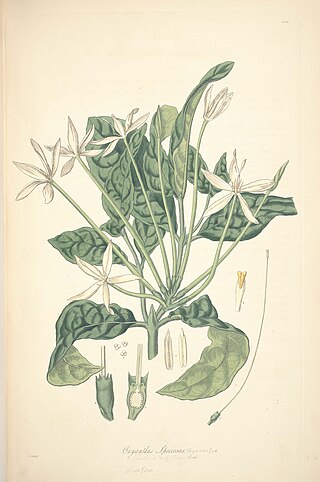
Oxyanthus is a genus of plant in family Rubiaceae. It contains the following species :

Rothmannia is a genus of flowering plants in the family Rubiaceae. It was described in 1776 and is named for Göran Rothman (1739–1778) by Thunberg – both were pupils of Linnaeus.
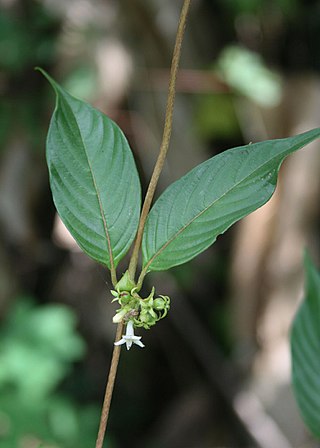
Sabicea is a genus of flowering plants in the family Rubiaceae. They are known commonly as the woodvines. The type species is Sabicea cinerea. There are about 145 species. Most are distributed in tropical Africa and South America.

Sericanthe is a genus of flowering plants in the family Rubiaceae. It is found in tropical and subtropical Africa. The genus was described by Elmar Robbrecht in 1978 based on the species in Neorosea, except for the type species, Neorosea jasminiflora, which went to Tricalysia. Bacterial leaf nodules are found in most of the species and the endophytic bacteria have been identified as Burkholderia.

Tricalysia is a genus of flowering plants in the family Rubiaceae. The genus is found in tropical and southern Africa and on the islands in the Western Indian Ocean.

Vangueria is a genus of flowering plants in the family Rubiaceae. The genus is named for Voa vanguer, as V. madagascariensis is known in Malagasy.

Vanguerieae is a tribe of flowering plants in the family Rubiaceae and contains 671 species in 29 genera. It is one of the most species-rich groups within the family and it is distributed across the Paleotropics.
Cuviera is a genus of flowering plants in the family Rubiaceae native to tropical Africa. It was originally described by Augustin Pyramus de Candolle in 1807 and is named after the French naturalist Georges Cuvier.
Globulostylis is a genus of flowering plants in the family Rubiaceae. It comprises 8 species growing in Central Africa.
Edrastima is a genus of flowering plants in the family Rubiaceae. The genus widespread and is found in Central and Eastern USA and the tropics and subtropics.

Acokanthera oblongifolia is a plant in the family Apocynaceae. It grows as an evergreen shrub or small tree up to 6 metres (20 ft) tall. Its fragrant flowers feature a white tinged pink corolla. The berries are purple when ripe. Its habitat is dry forest and coastal thickets. Acokanthera oblongifolia is used in local African medicinal treatments for snakebites, itches and internal worms. The plant has been used as arrow poison. The species is native to Mozambique and South Africa.
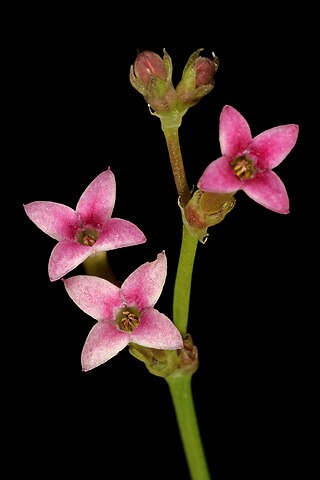
Cordylostigma is a genus in the Rubiaceae. The name was coined in 2010 to contain 9 species formerly belonging to the related genus Kohautia. The nine species are native to tropical and southern Africa from Guinea to Somalia to South Africa, as well as Madagascar, Comoros, and Réunion.
Colletoecema is a genus of flowering plants in the family Rubiaceae. It is the only genus in the tribe Colletoecemateae. The 3 species are found from west-central tropical Africa to Angola.
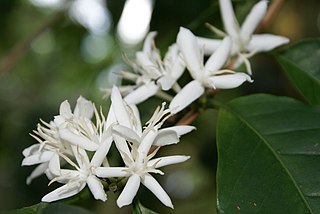
Coffeeae is a tribe of flowering plants in the family Rubiaceae and contains about 333 species in 11 genera. Its representatives are found in tropical and southern Africa, Madagascar, the western Indian Ocean, tropical and subtropical Asia, and Queensland.
Sabicea amazonensis is a species of plant in the family Rubiaceae. It is found in tropical South America. Zemagho, et al. assign Sabicea amazonensis to their subgenus, Sabicea Aubl. subgenus Sabicea, on the basis of morphological characters.













